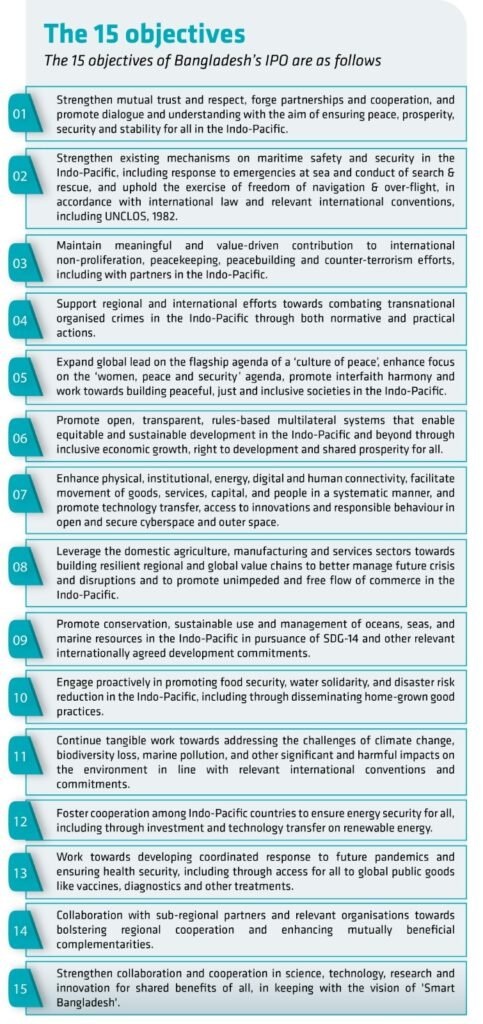In a significant geopolitical move, Bangladesh released a 15-point Indo-Pacific Outlook (IPO) on Monday, officially to illustrate its support for the Indo-Pacific Strategy led by the United States.
A day before prime minister Sheikh Hasina‘s visit to Japan began on Tuesday, Bangladesh declared its Indo-Pacific outlook, which prioritized a free, open, peaceful, secure, and inclusive Indo-Pacific for the prosperity of all. At a press conference at the foreign ministry in Dhaka, state minister for foreign affairs Md Shahriar Alam unveiled the final outlook in the presence of foreign minister AK Abdul Momen.
The Concept of Indo-Pacific Outlook
Geographically, the Indo-Pacific region consists of the tropical waters of the Indian Ocean, the western and central Pacific Ocean, and the connecting oceans. The region includes mainland African and Asian nations such as India and South Africa that border these oceans, Indian Ocean territories such as the Kerguelen Islands and Seychelles, the Malay Archipelago, Japan, Russia, and other Far East nations bordering the Pacific, Australia and all the Pacific Islands east of them, and Pacific nations of the Americas such as Canada and Mexico.
You can also read: What are the agendas of PM Hasina’s tri-nation official tour?
The Indo-Pacific strategy, which is the motivation for other nations to develop their own perspectives, gained momentum at the 2017 APEC meeting when US President Donald Trump announced a new approach to Asia: a Free and Open Indo-Pacific (FOIP). The release of the Indo-Pacific Strategy by the United States in February of last year prompted other nations to rapidly develop their own strategies. Numerous nations, including the United States, Australia, Britain, India, Indonesia, Japan, the Philippines, and Mongolia, have adopted Indo-Pacific strategies.

Recently, the European Union, United Kingdom, France, Germany, South Korea, and Canada announced their Indo-Pacific strategy. And most recently, Bangladesh released its Indo-Pacific Outlook (IPO) with 15 points. However, China is currently the only major Asian holdout.
What does Bangladesh’s IPO focuses on?
For the shared prosperity of all, the Bangladesh IPO envisions a free, open, tranquil, secure, and inclusive Indo-Pacific. “Being a littoral State of the Bay of Bengal, Bangladesh considers the stability and prosperity in the Indo-Pacific to be a crucial factor in realizing her “Vision 2041’, i.e. building a modern, knowledge-based developed country by 2041,” the introduction of the IPO said.
“The Indo-Pacific area’s collective share in global GDP, preponderance in international trade, enhanced climate action and growing technological dynamism can be key determinants for ensuring Bangladesh’s long-term resilience and prosperity,” Bangladesh state minister for foreign affairs Md Shahriar Alam said.
Bangladesh sends a distinct message that it is primarily concerned with improving the economy and citizens’ standards of life. The Indo-Pacific Strategy is essentially an alliance aimed at enhancing military security capabilities in the Bay of Bengal. Bangladesh’s “Indo-Pacific Outlook” focuses on infrastructure and economic development.
Foreign Minister Dr AK Abdul Momen said, “We are not following anyone. Our IPO is independent.”
The four guiding policies
The IPO was prepared with 15-point objectives based on four guiding principles. The four guiding policies determine the Bangladesh IPO. These are:

The 15 objectives
The 15 objectives of Bangladesh’s IPO are as follows:

Bangladesh avoids polarized narration of Indo-Pacific
Bangladesh will gain credibility with Western nations with the help of this IPO. Since China maintains isolation from U.S.-led Indo-Pacific policymaking and is a major development partner of Bangladesh, the question rises whether China will react to Bangladesh’s most recent IPO.
To date, it does not appear that there are any concerns that could directly oppose mutual trust, respect, bilateral treaties, or shared economic prosperity among the nations of the Indo-Pacific. The 15-point outlook emphasized security as a prerequisite for economic prosperity and clarified that Dhaka does not favor either China or the United States in the region’s intensifying geopolitical competition. Therefore, the Bangladeshi government avoided polarizing narratives when presenting its IPO.
In addition, other nations and organisations avoid adopting targeted perspectives against China. South Korea, for example, seeks for inclusiveness. It views China as a crucial partner for attaining peace and prosperity in the Indo-Pacific region. The EU also asserts that its perspective is inclusive of all cooperating parties. ASEAN encourages an inclusive approach to concepts and proposals. This demonstrates that not all parties view the Indo-Pacific through the lens of great power competition; some, like Bangladesh, endorse a cooperative approach.
The Indo-Pacific has unquestionably become a central region of global politics, and its significance will continue to grow. Promoting a comprehensive view of the Indo-Pacific is a current attempt to present Bangladesh as an involved, responsible, and engaged member of the community. In the current climate of world politics, where Bangladesh has chosen to collaborate with all stakeholders on peacekeeping, peacebuilding, and counterterrorism initiatives, this will provide clarity and minimize misunderstandings, both of which are crucial.


